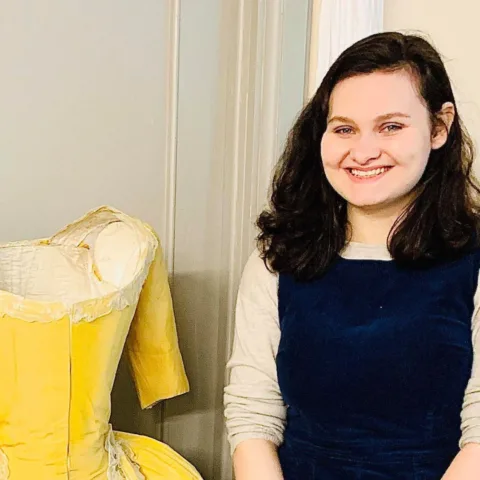The Bowes Museum Blog

Laurie Endean, Textile Conservation Intern
I’ve been at The Bowes Museum almost a full year and as with the nature of a 12 month internship, I’ll be waving “Adieu” to the French style Château on the edge of Barnard Castle, hoping to return in the future…
It’s been a packed year, with a lot of ups and downs. I’ve been commuting from Gateshead every day, a round trip of about 100 miles which got easier with the lighter nights in spring and summer but I’m thanking my lucky stars I don’t have to drive along those small roads on any more dark winter mornings!
Yellow Polonaise before & after Conservation
Since my last blog post, I’ve been working on finishing the yellow Polonaise dress, belonging to Tullie House – If you click back you can see a picture of the petticoat being washed – we did the same treatment with the bodice and skirt (pictured).
The lace on the dress was in quite discoloured and had curled in on itself through damage after losing a lot of its structure. It had to be removed before we ed the dress in case it picked up any fugitive yellow dye. While it was off, I thought it was a good opportunity to wash it separately and see if I could conserve any of the damaged areas. There had previously been some conservation work done to it however this had been carried out without removing it from the dress which added extra weight to the lace causing more rips and holes.

The lace from around the edge of the bodice and skirt before conservation.
The lace was washed with old conservation net still attached. Once it was dry I removed the net and humidified the lace using spray before easing it out flat and putting some glass weights on it. I used the same technique on the conservation net I’d removed as it was perfectly good to use again if needed.
Picture left: Lace after the removal of original conservation netting, before conservation
Picture right: The same piece of lace being weighted after humidification.

Conservation netting placed and pinned into position over the damaged areas, to be stitched down using couching stitch.

The box pleats being weighted down; many were happy to return into their original shape, which is why some look a bit wonky.
The conservation netting I had removed was placed over a damaged area of the same size and couching-stitched into position. This is a way of supporting the damage and the surrounding area so the damage won’t spread.
I then needed to replace the pleats in the lace, so again I humidified it while it was flat. Then using the more stubborn original creases in the fabric and the shaping along the edges that had developed over time, I was able to create folds and weight them overnight so they would return to their original box-pleat shape. After all three pieces of lace had been treated I re-attached them to the Yellow Polonaise and you can see the result in the picture above!
I have been out and about a bit too, we visited another intern, Scarlett at The Royal Armories in Leeds and she has a fascinating job working with chain-mail shirts, weaponry and decorative armour.
I popped in to see old colleagues at Tyne and Wear Archives and Museums and Durham University’s Conservation Unit as well as meeting other Conservators in the North East region. And I also made it to The People’s History Museum in Manchester to talk to their Conservators about the type of things they get to work on including the huge Union and Miners Banners in their collection. Many thanks to all of those Conservation practices that have welcomed me, it has been very helpful and insightful.
While I’m saying goodbye to The Bowes Museum, it hopefully won’t be for too long as they’ve invited me to return on a Freelance Basis for specific projects.
Thanks to The Bowes Museum for giving me the opportunity to work on their fabulous collection for the past year and also to Icon and the National Heritage Lottery Funding who provide these opportunities for those wishing to extend their knowledge base and practical skills in the Heritage sector.

Written by Laurie Endean-Olsen, The National Lottery Heritage Fund & ICON/The Institute of Conservation Intern in Textiles Conservation at The Bowes Museum.







